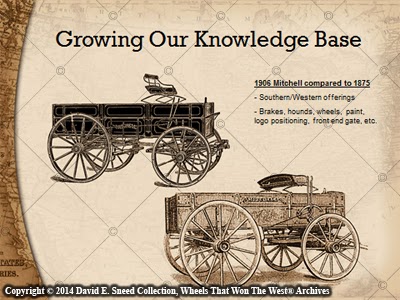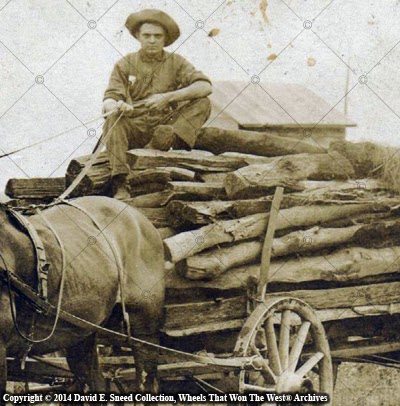We receive a lot of questions asking where information about different vehicles can be found. The good news is there are quite a few sources. The bad news is - there are quite a few sources. In other words, it's a massive and complex subject too large for any single volume and, tragically, not all resources have sufficiently vetted their 'research'. Over and over, I've shared the complexity of this subject and the need for careful answers. Take, for instance, the front axle of a 'simple' farm wagon. Sounds like a pretty straight-forward topic with a basic design that could be written about in a paragraph or two, right? Unfortunately, that's far from being the case. In fact, as I'm writing this, I quickly thought of over two dozen variations in front axle configurations; each with its own story to tell.
 |
| Built in the same factory, these two Mitchell brand wagon designs are separated by about 30 years. As a result, there are innumerable differences between them. |
Differences in the front axle can include whether the axle is determined to be a solid - steel, iron, wood - or is it one of a number of hollow or combination patterns? Other distinctions can be found in the axle shape, length, height, depth, weight capacity, spacer design, presence of a truss rod or bar, skein size, skein type (cast or steel), and skein design -there are innumerable skein designs including those with innovative oil caps, sand bands, and other features. Is the axle equipped with roller bearings? If so,are they of a Timken or larger steel pin variety? If pins, how many and what size are they? How are the wheels affixed to the skeins - by linch pin or nut? Is the axle through-bolted or clipped? How are the stay-chain hooks attached or are there any? Where is the hound bracing attached? Does the axle move or is it a fixed, auto-steer type? What about surviving maker marks/stamps/castings? Truly, the list can be overwhelming but each piece can tell us something about how the vehicle was used as well as potentially pointing us to a maker and even a timeframe of manufacture. Reliable information on all of this - and much more - is not typically available. It's one of the primary reasons we're continually encouraged to share such rare details through this blog.

Note the wooden stake inserted into the bolster standard rings on this wagon gear. This side support extension is just one of the purposes of the design and is a feature/benefit not typically pointed out among modern writings.
Because of the subject size, when starting out, I'd recommend focusing on a specific type of vehicle, region of the country, or timeframe before trying to tackle all of the obstacles at once. Below are a few suggested books covering different vehicle backgrounds and types. This is far from a conclusive list as there are countless other publications with varying degrees of important details. So, with each being a vast subject in and of itself, don't fall into the trap of believing you'll find a single book or two that will answer all the knowledge you'll ever need. Our society may have us accustomed to eating fast food, but if you move too fast with assumptions here, this field of study can eat your lunch; leaving you with nothing but egg-on-your-face and plenty of humble pie to carry around.
Early Freighting...
"From the Missouri to the Great Salt Lake, An Account of Overland Freighting" by William E. Lass, 1972
"The Twenty Mule Team of Death Valley" by Ted Faye, 2012
"Empire On Wheels" by Mary Lund Settle and Raymond W. Settle, 1949
"I Hauled These Mountains In Here!" by Frances & Dorothy Wood, 1977
"The Old Pike - A History of the National Road" by Thomas B. Searight, 1894
"Conestoga Wagon 1750-1850" by George Shumway, Edward Durell, & Howard C. Frey, 1964-1966, 1968
"Wagons for the Santa Fe Trade" by MarkL. Gardner, 2000
"War Drums & Wagon Wheels" by Raymond W. and Mary Lund Settle, 1966
"Commerce of the Prairies" by Josiah Gregg, 1844
Coaches & Coaching...
"Wagons, Mules and Men" by Nick Eggenhofer, 1961
"My Playhouse Was A Concord Coach" by Mae Helene Bacon Boggs, 1942
"Time Well Kept" by Wells Fargo Historical Services, 2011
"Via Western Express & Stagecoach" by Oscar Osburn Winther, 1945
"Six Horses" by Captain William Banning & George Hugh Banning, 1928
"Old Waybills" by Alvin F. Harlow, 1934
"Stagecoach West" by Ralph Moody, 1967
Military Vehicles...
"The Great Blue Army Wagon" by Thomas Lindmier, 2009
"Horse-Drawn Ambulances" by Carriage Museum of America, 2004
"Cannons: An Introduction to Civil War Artillery" by Dean S. Thomas, 1985
"History & Description of an Ambulance Wagon" by Thomas W. Evans, M.D., 1868
General horse-drawn vehicle history...
"The Carriage Trade" by Thomas A. Kinney, 2004
"Borrowed Time - A Tribute To The Wheels That Built The American West" by David Sneed, 2011
"Wagon-Making in the United States" by Paul A. Kube, 2005
"The Prairie Traveler" by Randolph B.Marcy, 1859
"Platte River Road Narratives" by Merril J. Mattes, 1988
"Carriage Terminology: An Historical Dictionary" by Don H. Berkebile, 1978
"Wheels West, 1590-1900" by Richard Dunlop, 1977
"The Old Reliable - The History of the Springfield Wagon Company" by Steven Lee Stepp, 1972